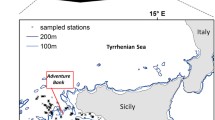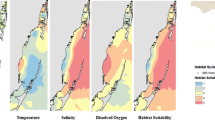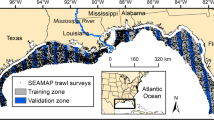Abstract
Knowledge about distribution and habitat requirements of species is important for analyzing their role in marine ecosystems or establishing sanctuaries. However, knowledge is scarce especially in many chondrichthyan species. In this study, the spatial distribution of the stingray Neotrygon kuhlii on the Australian North and Northwest Shelf was predicted model-based for the first time. Predictions based on two different types of habitat suitability models, logistic regression and maximum entropy modeling. Catch data of N. kuhlii from Australian trawl surveys combined with randomly selected pseudo-absences were used for modeling together with data sets of several environmental variables. Both modeling methods yielded plausible and validated habitat suitability models containing water depth and salinity as significant independent variables. The model-based predictions of the probability of occurrence of N. kuhlii were similar for both methods and thus emphasized the goodness of the models. Following the predictions, N. kuhlii has its highest probability of occurrence in about 60 m water depth and at a salinity of about 35 PSU. The results indicate that both modeling methods are powerful tools to predict spatial distribution and habitat quality for marine fish species. Therefore, they are suitable for detecting possible distribution in areas with only few field records.
Similar content being viewed by others
References
Amante, C. and Eakins, B.W., ETOPO1 1 arc-minute global relief model: procedures, data sources and analysis, NOAA Tech. Mem. NESDIS NGDC-24, 2009.
Austin, M.P., Spatial prediction of species distribution: an interface between ecological theory and statistical modelling, Ecol. Model., 2002, vol. 157, nos. 2–3, pp. 101–118.
Backhaus, K., Erichson, B., Plinke, W., and Weiber, R., Multivariate Analysemethoden. Eine anwendungsorientierte Einführung, Berlin: Springer, 2006, 11th ed.
Camhi, M., Fowler, S.L., Musick, J.A., Bräutigam, A., and Fordham, S.V., Sharks and their Relatives — Ecology and Conservation, IUCN/SSC Occ. Pap., no. 20, 1998.
Camhi, M.D., Valenti, S.V., Fordham, S.V., Fowler, S.L., and Gibson, C. The Conservation Status of Pelagic Sharks and Rays: Report of the IUCN Shark Specialist Group Pelagic Shark Red List Workshop, Newbury: IUCN/SSC Shark Specialist Group, 2009.
Chen, H., Chen, L.J., and Albright, T.P., Predicting the potential distribution of invasive exotic species using GIS and information-theoretic approaches: A case of ragweed (Ambrosia artemisiifolia L.) distribution in China, Chin. Sci. Bull., 2007, vol. 52, no. 9, pp. 1223–1230.
Crawley, M.J., GLIM for Ecologists, Oxford: Blackwell Publishing, 1993.
Crawley, M.J., Statistical Computing — An Introduction to Data Analysis using S-Plus, Chichester: Wiley, 2002.
CSIRO, CSIRO Marine Data Trawler, 2004. www.marine.csiro.au/warehouse/isp/loginpage.jsp. Accessed April 12, 2010.
Daley, R.K., Stevens, J.D., Last, P.R., and Yearsley, G.K., Field Guide to Australian Sharks and Rays, reprint with minor correction, Melbourne: CSIRO Publ., 2007.
Dudík, M., Phillips, S.J., and Schapire, R.E., Performance Guarantees for Regularized Maximum Entropy Density Estimation, in Proceedings of the 17th Annual Conference on Computational Learning Theory, 2004, pp. 472–486.
Elith, J., Quantitative methods for modelling species habitat: comparative performance and an application to Australian plants, in Quantitative Methods for Conservation Biology, New York: Springer, 2000, pp. 39–58.
Elith, J. and Graham, C.H., Do they? How do they? WHY do they differ? — on finding reasons for differing performances of species distribution models, Ecography, 2009, vol. 32, no. 1, pp. 66–77.
Elith, J., Graham, C.H., Anderson, R.P., et al., Novel methods improve prediction of species’ distributions from occurrence data, Ecography, 2006, vol. 29, no. 2, pp. 129–151.
Elith, J., Phillips, S.J., Hastie, T., et al., A statistical explanation of MaxEnt for ecologists, Diversity Distrib., 2011, vol. 17, no. 1. pp. 43–57
ESRI, ArcMap ver. 9.3.1, Redlands: Environ. Syst. Res. Inst., 1999–2009.
Fahmi and White, W., Dasyatis kuhlii, in IUCN 2010, IUCN Red List of Threatened Species, ver. 2010.2, 2007. http://www.iucnredlist.org. Accessed August 16, 2010.
Ferrier, S. and Watson, G., An Evaluation of the Effectiveness of Environmental Surrogates and Modelling Techniques in Predicting the Distribution of Biological Diversity, Canberra: Dpt. Environ., Sports Territ., Commonwealth Aust. NSW National Parks and Wildlife Service, 1997.
Ferrier, S., Watson, G., Pearce, J., and Drielsma, M., Extended statistical approaches to modelling spatial pattern in biodiversity in northeast New South Wales. I. Species-level modelling, Biodiversity Conserv., 2002, vol. 11, no. 12, pp. 2275–2307.
Fielding, A.H. and Bell, J.F., A review of methods for the assessment of prediction errors in conservation presence/absence models, Environ. Conserv., 1997, vol. 24, no. 1, pp. 38–49.
Fielding, A.H. and Haworth, P.F., Testing the generality of bird-habitat models, Conserv. Biol., 1995, vol. 9, no. 6, pp. 1466–1481.
Finanztip, Zufallsgenerator: z. B. Lottozahlen tippen, 2010. http://www.finanztip.de/tip/service/lottozahlengeneratorzufallszahl.htm. Accessed July 22, 2010.
Forsskål, P., Descriptiones animalium: avium, amphibiorum, piscium, insectorum, vermium; quae in itinere orientali observavit. Post mortem auctoris edidit Carsten Niebuhr, Copenhagen, 1775.
Fowler, S.L., Cavanagh, R.D., Camhi, M., et al., Sharks, Rays and Chimaeras: The Status of the Chondrichthyan Fishes. Status Survey, Cambridge: IUCN/SSC Shark Specialist Group, 2005.
Graham, C.H., Ferrier, S., Huettman, F., Moritz, C., and Townsend Peterson, A., New developments in museum-based informatics and applications in biodiversity analysis, Trends Ecol. Evol., 2004, vol. 19, no. 9, pp. 497–503.
Griffiths, S.P., Brewer, D.T., Heales, D.S., Milton, D.A., and Stobutzki, I.C., Validating ecological risk assessments for fisheries: assessing the impacts of turtle excluder devices on elasmobranch bycatch populations in an Australian trawl fishery, Mar. Freshwater Res., 2006, vol. 57, no. 4, pp. 395–401.
Guisan, A. and Thuillier, W., Predicting species distribution: offering more than simple habitats models, Ecol. Lett., 2005, vol. 8, no. 9, pp. 993–1009.
Guisan, A. and Zimmermann, N.E., Predictive habitat distribution models in ecology, Ecol. Model., 2000, vol. 135, nos. 2–3, pp. 147–186.
Hendricks, P., Maxell, B., Lenard, S., and Currier, C., Surveys and Predicted Distribution Models for Land Mollusks on USFS Northern Region Lands: 2007. A report to the USDA Forest Service, Northern Region, Helena: Montana Natural Heritage Program, 2008.
Hirzel, A.H., Le Lay, G., Helfer, V., Randin, C., and Guisan, A., Evaluating the ability of habitat suitability models to predict species presences, Ecol. Model., 2006, vol. 199, no. 2, pp. 142–152.
Hosmer, D.W. and Lemeshow, S., Applied Logistic Regression, New York: Wiley, 2000, 2nd ed.
IOC, IHO, and BODC, Centenary Edition of the GEBCO Digital Atlas, Liverpool, UK: British Oceanographic Data Centre, 2008.
Jacobsen, I.P. and Bennett, M.B., Feeding ecology and dietary comparisons among three sympatric Neotrygon (Myliobatoidei: Dasyatidae) species, J. Fish Biol., 2012, vol. 80, no. 5, pp. 1580–1594.
Kaschner, K., Ready, J.S., Agbayani, E. et al., AquaMaps: Predicted range maps for aquatic species, 2008. http://www.aquamaps.org. Accessed March 17, 2010.
Last, P.R., New Australian fishes. Part 14: Two new species of Dasyatis (Dasyatidae), Mem. Nat. Mus. Vic., 1987, vol. 48, no. 1, pp. 57–61.
Last, P.R. and Compagno, L.J.V., Dasyatidae, in FAO Species Identification Guide for Fishery Purposes. The Living Marine Resources of the Western Central Pacific. Vol. 3: Batoid Fishes, Chimaeras and Bony Fishes Part 1 (Elopidae to Linophrynidae), Carpenter, K.E. and Niem, V.H., Eds., Rome: FAO, 1999.
Last, P.R., Stevens, J.D., Sharks and Rays of Australia, Melbourne: CSIRO Publ., 2009, 2nd ed.
Manel, S., Williams, H.C., and Ormerod, S.J., Evaluating presence-absence models in ecology: the need to account for prevalence, J. Appl. Ecol., 2001, vol. 38, no. 5, pp. 921–931.
Müller, J. and Henle, F.G.J., Systematische Beschreibung der Plagiostomen, Berlin: Veit & Comp., 1841, pp. 103–200.
Myers, R. and Worm, B., Rapid worldwide depletion of predatory fish communities, Nature, 2003, vol. 423, pp. 280–283.
Nagelkerke, N.J.D., A note on a general definition of the coefficient of determination, Biometrika, 1991, vol. 78, no. 3, pp. 691–692.
O’Shea, O.R., Thums, M., van Keulen, M., and Meekan, M., Bioturbation by stingrays at Ningaloo Reef, Western Australia, Mar. Freshwater Res., 2012, vol. 63, no. 3, pp. 189–197.
Pearce, J.L. and Boyce, M.S., Modeling distribution and abundance with presence-only data, J. Appl. Ecol., 2006, vol. 43, no. 3, pp. 405–412.
Petkovic, P., and Buchanan, C., Australian Bathymetry and Topography Grid, Canberra: Geoscience Australia, 2002. http://wwvv.ga.gov.au/general/technotes/20011023-32.jsp. Accessed November 11, 2002.
Phillips, S.J. and Dudík, M., Modeling of species distributions with Maxent: new extensions and a comprehensive evaluation, Ecography, 2008, vol. 31, no. 2, pp. 161–175.
Phillips, S.J., Dudík, M., and Schapire, R.E., A maximum entropy approach to species distribution modeling, in Proceedings of the 21st International Conference on Machine Learning, New York: ACM Press, 2004.
Phillips, S.J., Anderson, R.P., and Schapire, R.E., Maximum entropy modeling of species geographic distributions, Ecol. Model., 2006, vol. 190, nos. 3–4, pp. 231–259.
Pierce, S.J. and Bennett, M.B., Validated annual, bandpair periodicity and growth parameters of blue-spotted maskray Neotrygon kuhlii from south-east Queensland, Australia, J. Fish Biol., 2009, vol. 75, no. 10, pp. 2490–2508.
Pierce, S.J., Pardo, S.A., and Bennett, M.B., Reproduction of the blue-spotted maskray Neotrygon kuhlii (Myliobatoidei: Dasyatidae) in south-east Queensland, Australia, J. Fish Biol., 2009, vol. 74, no. 6, pp. 1291–1308.
Pitcher, C.R., Doherty, P., Arnold, P., et al., Seabed Biodiversity on the Continental Shelf of the Great Barrier Reef World Heritage Area, AIMS/CSIRO/QM/QDPI CRC Reef Research Task Final Report, 2007a.
Pitcher, C.R., Haywood, M., Hooper, J., et al., Mapping and characterisation of key biotic and physical attributes of the Torres Strait ecosystem, CSIRO/QM/QDPI CRC Torres Strait Task Final Report, 2007b.
Ridgway, K.R., Dunn, J.R., and Wilkin, J.L., Ocean Interpolation by Four-Dimensional Weighted Least Squares — Application to the Waters around Australasia, J. Atmos. Ocean. Tech., 2002, vol. 19, no. 9, pp. 1357–1375.
Schröder, B. and Reineking, B., Modellierung der Art-Habitat-Beziehung — ein Überblick über die Verfahren der Habitatmodellierung, in Habitatmodelle — Methodik, Anwendung, Nutzen. Tagungsband zum Workshop vom 8–10 Oktober, 2003 am UFZ Leipzig, UFZ-Berichte 9/2004, Dormann, C.F., Blaschke, T., Lausch, A., Schrïder, B., and Söndgerath, D., Eds., Leipzig: Eigenverlag UFZ, 2004.
Schröder, B. and Richter, O., Are habitat models transferable in space and time? J. Nat. Conserv., 1999, vol. 8, no. 4, pp. 195–205.
Stobutzki, I.C., Miller, M.J., Heales, D.S., and Brewer, D.T., Sustainability of elasmobranchs caught as bycatch in a tropical prawn (shrimp) trawl fishery, Fish. Bull., 2002, vol. 100, no. 4, pp. 800–821.
Strau, B., Habitatmodelle zur Prognose der Vorkommen phytophager Insekten in Mosaikzyklen, BSc (Hons) Thesis, Oldenburg: Carl von Ossietzky University, 2002.
Systat Software, Inc., SigmaPlot 12.0, Chicago: Systat Software, 2011.
ter Braak, C.J.F. and Looman, C.W.N., Weighted averaging, logistic regression and the Gaussian response model, Vegetatio, 1986, vol. 65, no. l, pp. 3–11.
Thuiller, W. and Münkemüller, T., Habitat suitability modelling, in Effects of Climate Change on Birds, Møller, A.P., Fiedler, W., and Berthold, P., Eds., New York: Oxford Univ. Press, 2010.
Ward, G., Hastie, T., Barry, S., Elith, J., and Leathwick, J.R., Presence-Only Data and the EM Algorithm, Biometrics, 2009, vol. 65, no. 2, pp. 554–563.
Ward, R.D., Holmes, B.H., White, W.T., and Last, P.R., DNA barcoding Australasian Chondrichthyans: results and potential uses in conservation, Mar. Freshwater Res., 2008, vol. 59, no. 1, pp. 57–71.
Weigmann, S., Contribution to the taxonomy and distribution of eight ray species (Chondrichthyes, Batoidea) from coastal waters of Thailand, Proc. Soc. Nat. Sci., Hamb. 2011, vol. 46, pp. 249–312.
Weigmann, S., Contribution to the Taxonomy and Distribution of Six Shark Species (Chondrichthyes, Elasmobranchii) from the Gulf of Thailand, ISRN Zool., 2012, vol. 2012, Article ID 860768.
White, W.T. and Dharmadi, Species and size compositions and reproductive biology of rays (Chondrichthyes, Batoidea) caught in target and non-target fisheries in eastern Indonesia, J. Fish. Biol., 2007, vol. 70, no. 6, pp. 1809–1837.
Wintle, B.A., Elith, J., and Potts, J.M., Fauna habitat modelling and mapping: a review and case study in the Lower Hunter Central Coast Region of NSW, Austral Ecol., 2005, vol. 30, no. 7, pp. 719–738.
Wisz, M.S. and Guisan, A., Do pseudo-absence selection strategies influence species distribution models and their predictions? An information-theoretic approach based on simulated data, BMC Ecol., 2009, vol. 9, no. 8.
Zaniewski, A.E., Lehmann, A., and Overton, J.M., Predicting species distribution using presence-only data: a case study of native New Zealand ferns, Ecol. Model., 2002, vol. 157, nos. 2–3, pp. 261–280.
Author information
Authors and Affiliations
Corresponding author
Additional information
The article is published in the original.
Rights and permissions
About this article
Cite this article
Weigmann, S., Thiel, R. Predicting the spatial distribution of the blue-spotted maskray Neotrygon kuhlii (Myliobatiformes, Dasyatidae) on the Australian North and Northwest Shelf comparing two different methods of habitat modeling. J. Ichthyol. 53, 628–640 (2013). https://doi.org/10.1134/S0032945213050111
Received:
Published:
Issue Date:
DOI: https://doi.org/10.1134/S0032945213050111




